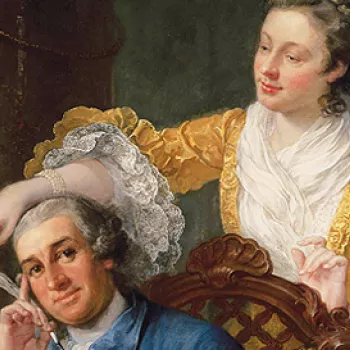Attributed to Liverpool : Richard Chaffers (active 1754-1765)
George II (1683-1760) 1757-59
Soft-paste porcelain | 43.0 x 32.8 x 16.2 cm (whole object) | RCIN 45085
-
Soft-paste porcelain bust of George II, looking half to the right, wearing a cloak clasped at the front over a cuirass, embossed with floral scrolls, the Star of the Order of the Garter on his breast; on a shaped rectangular plinth.
This bust of George II is one of about twenty to survive and it has not been possible to trace with certainty which factory created them. The most likely is the Liverpool manufactory run by Richard Chaffers. This attribution is based on the consistency of the porcelain which contains a high percentage of soap-rock, which was mined under licence from Cornwall. Richard Chaffers was known to have held a licence for its use. However, the factories at Vauxhall and Bow in London and another in Plymouth have also been suggested as possible sources for the figure.
The size and thickly modelled clay show that the factory, whichever it was, was experimenting with the creation of large-scale pieces. A number of the versions of the bust have brackets modelled into the reverse to support the hollow back, and the bust is affixed to its socle with a large wooden screw. Although large pieces of this kind are rare in England, this was a time of experimentation throughout Europe. The chief modeller at Meissen, Charles Kändler, wrote in 1739 that ‘everything can be made and achieved in porcelain, whatever one desires’. The bust has been glazed in pale blueish-green glaze – possibly intended to resemble the celadon glazes of Chinese porcelain.
At least one version of this bust was supplied with an elaborate rococo wall bracket modelled with Britannia and St George, and celebrating British military victory (V&A Museum, London, 414:134-1885A ). Certainly the martial aspect of the king, who wears both armour and a Garter Star, suggests that these busts were created after the victories in America and India in 1759, during the Seven Years’ War (1754-63); it is even possible that the bust was created posthumously. The sculptor has in the past been named as both John Michael Rysbrack (1694-1770) and Louis-François Roubiliac (1702/5-1762) although the modelling is not sophisticated enough for either, and the most common attribution is John Cheere (1709-87). Cheere sold plaster casts of his works from his premises on Hyde Park Corner to a number of porcelain factories.
Text adapted from The First Georgians; Art and Monarchy 1714 - 1760, London, 2014.Provenance
Acquired by Queen Mary c.1950.
-
Creator(s)
Attributed to (porcelain manufacturer)Acquirer(s)
-
Medium and techniques
Soft-paste porcelain
Measurements
43.0 x 32.8 x 16.2 cm (whole object)









